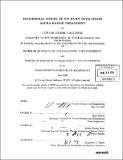Isothermal model of ICF burn with finite alpha range treatment
Author(s)
Galloway, Conner Daniel (Conner Daniel Cross)
DownloadFull printable version (8.319Mb)
Alternative title
Isothermal model of inertial confinement fusion burn with finite alpha range treatment
Other Contributors
Massachusetts Institute of Technology. Dept. of Nuclear Science and Engineering.
Advisor
Kim Molvig.
Terms of use
Metadata
Show full item recordAbstract
A simple model for simulating deuterium tritium burn in inertial confinement fusion capsules is developed. The model, called the Isothermal Rarefaction Model, is zero dimensional (represented as ordinary differential equations) and treats disassembly in the isothermal limit. Two substantive theoretical developments are contained in this model; one is an improved treatment of fast alpha slowing down, and the other is a calculation of the fusion product source distributions and their energy moment. The fast alpha stopping treatment contains a derivation of the Fraley fractional energy splitting functional form, fe = 1/(1 + xTe), resulting in an expression for the numerical factor x which will be defined as the Fraley parameter. The average thermal energy which is lost from the thermal ion distribution when two particles fuse is found from the energy moment of the fusion product source distribution. This energy contributes to the energy of the fusion products. A third theoretical development that is discussed for completeness and future use, but not yet incorporated in the Isothermal Rarefaction Model, is the 4T theory of matter-radiation energy exchange in homogenous optically thick media. The isothermal rarefaction model assumes an optically thin to marginally thick plasma, and only Bremsstrahlung emission and absorption are treated in this thesis. The 4T theory for optically thick media has been published. A sampling of results using the Isothermal Rarefaction Model is presented.
Description
Thesis (S.M. and S.B.)--Massachusetts Institute of Technology, Dept. of Nuclear Science and Engineering, 2009. Cataloged from PDF version of thesis. Includes bibliographical references (p. 67).
Date issued
2009Department
Massachusetts Institute of Technology. Department of Nuclear Science and EngineeringPublisher
Massachusetts Institute of Technology
Keywords
Nuclear Science and Engineering.